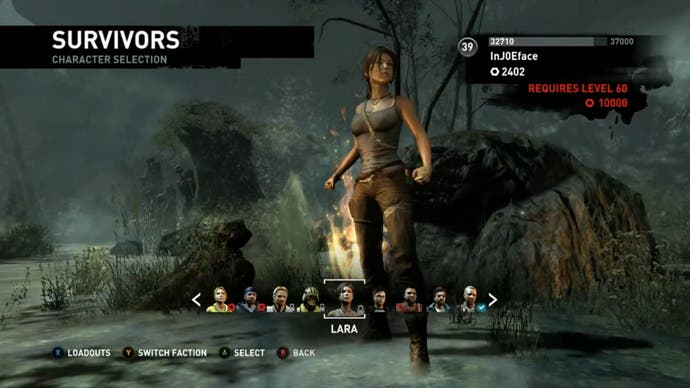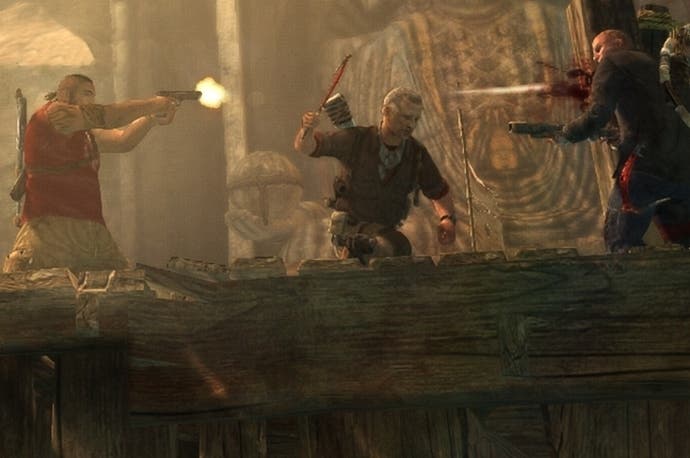You weren't the only one confused by Tomb Raider's multiplayer
"We don't have to have multiplayer to have a successful single-player. I do agree on that."
Confused as to why Crystal Dynamic's Tomb Raider reboot has felt the need to include a multiplayer mode? Don't worry - you're not alone. "Yeah, that first reaction," reflects Eidos Montreal's Daniel Bisson as he thinks back to the wall of bemusement that met the announcement. "You know, I did the same thing - why do a multiplayer Tomb Raider?"
When it was announced early last week, Tomb Raider's multiplayer was met if not with derision then certainly with a shrug of the shoulders, especially in light of games like BioShock Infinite and Dishonored that prove a multiplayer mode doesn't have to be the cost of entry for a game with triple-A pretentions. "My reaction to that is, I agree," says Bisson. "We don't have to have multiplayer to have a successful single-player. I do agree on that. I do agree that it's not critical to do that."
So why's it there?
"There are two reasons. The first is a selfish reason of mine. With single player, there's a start and there's an end. And you have some games with a rich universe, and you think you want to stay there forever and then it ends.
"You want to stay in that universe - there are some games like that. One of things that was pitched was can we make that Tomb Raider universe persistent? We wanted to do that, and we explored new maps and new types of gameplay, and for me that's very meaningful - taking that world and making it persistent.

"The second thing comes from Crystal. I think they had some success with Guardian of Light, but when they were doing it people were asking why they were doing it. They stuck to their guns and they ended up with something pretty successful, and that was pretty good, and Darryl [Gallagher, Crystal Dynamics' head] came in and said he wanted to push that, he wanted to create that core experience and have it also a competitive experience."
Guardian of Light, the isometric action game that turned Tomb Raider into an arcade-like experience with some success, keeps on being summoned by developers keen to remind people that Lara's world can be twisted into all shapes and sizes. It's hard to say whether Tomb Raider's multiplayer can repeat the trick from a handful of matches, although it's certainly not a disaster.
There's a team deathmatch mode that's probably not the best fit for a game that's still a little rough around the edges; hit-boxes are fuzzy while the combat - admittedly an aeon ahead of that offered in past Tomb Raiders - doesn't have the snap and crackle of the games it'll be competing against in the crowded online space.
Survivor mode, however, has a little more to it. Two teams are battling it out on a map, one's objective being to capture and collect medi-packs while the other's out to tally up 20 kills. The kick, though, comes in its oh-so-fashionable asymmetry - the survivors who are hunting down the med-packs can be felled easily enough by the scavengers, but once they're down they're not truly out until they've either got a hatchet in the head or have bled out.
It's a talent that's not extended towards the scavengers, meaning that not only are the objectives of the two teams different but so are their skills. Helping it all along is a map that's alive with possibility - traps can be set, whipping up unknowing enemies into the air so they're easy meat, while a sandstorm can be triggered that blinds the opposition while allowing you to hold on to a small slither of visibility.

It's fun, although it's hardly sensational, and it may be a push to expect players to see their way through the leveling system that works towards unlocking Lara as a playable model (although it's certainly a generous game, at the outset at least - I was awarded 1500 points for losing my first game. For reasons that'll be apparent to anyone who's seen me with a controller, I'm afraid I can't tell you what the reward is for winning).
The team behind it is, for now, modest with its ambitions for the mode. "Let's be honest, it's not oh my god this is a revelation," admits Bisson. "It's a first step. If it's powerful, if it works well, we're going to continue and we're going to build on that. For us it's about making an experience that's a little different. It's not ground-breaking, but it's fun, and it's Tomb Raider."
It perhaps isn't the Tomb Raider that's embedded in the minds of a certain generation of players, the one that's about solitary exploration and acrobatics. But in the context of the reboot, an effort that's the very model of a modern mega-game, it definitely fits right in.













.png?width=291&height=164&fit=crop&quality=80&format=jpg&auto=webp)


